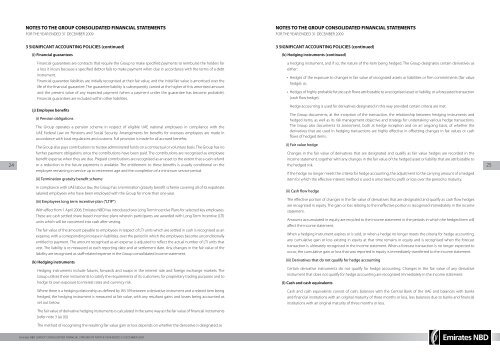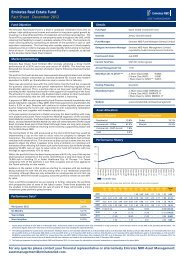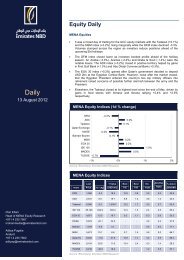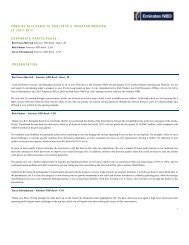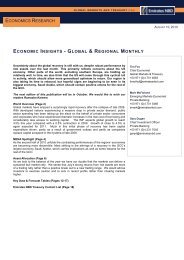Where the world comes to bank - Emirates NBD
Where the world comes to bank - Emirates NBD
Where the world comes to bank - Emirates NBD
Create successful ePaper yourself
Turn your PDF publications into a flip-book with our unique Google optimized e-Paper software.
NOTES TO THE GROUP CONSOLIDATED FINANCIAL STATEMENTS<br />
FOR THE YEAR ENDED 31 DECEMBER 2009<br />
3 SIGNIFICANT ACCOUNTING POLICIES (continued)<br />
(i) Financial guarantees<br />
Financial guarantees are contracts that require <strong>the</strong> Group <strong>to</strong> make specified payments <strong>to</strong> reimburse <strong>the</strong> holders for<br />
a loss it incurs because a specified deb<strong>to</strong>r fails <strong>to</strong> make payment when due in accordance with <strong>the</strong> terms of a debt<br />
instrument.<br />
Financial guarantee liabilities are initially recognised at <strong>the</strong>ir fair value, and <strong>the</strong> initial fair value is amortised over <strong>the</strong><br />
life of <strong>the</strong> financial guarantee. The guarantee liability is subsequently carried at <strong>the</strong> higher of this amortised amount<br />
and <strong>the</strong> present value of any expected payment (when a payment under <strong>the</strong> guarantee has become probable).<br />
Financial guarantees are included within o<strong>the</strong>r liabilities.<br />
(j) Employee benefits<br />
(i) Pension obligations<br />
The Group operates a pension scheme in respect of eligible UAE national employees in compliance with <strong>the</strong><br />
UAE Federal Law on Pensions and Social Security. Arrangements for benefits for overseas employees are made in<br />
accordance with local regulations and cus<strong>to</strong>ms. Full provision is made for all accrued benefits.<br />
The Group also pays contributions <strong>to</strong> trustee administered funds on a contractual or voluntary basis. The Group has no<br />
fur<strong>the</strong>r payment obligations once <strong>the</strong> contributions have been paid. The contributions are recognised as employee<br />
benefit expense when <strong>the</strong>y are due. Prepaid contributions are recognised as an asset <strong>to</strong> <strong>the</strong> extent that a cash refund<br />
24 or a reduction in <strong>the</strong> future payments is available. The entitlement <strong>to</strong> <strong>the</strong>se benefits is usually conditional on <strong>the</strong><br />
<strong>the</strong> hedged risk.<br />
25<br />
employee remaining in service up <strong>to</strong> retirement age and <strong>the</strong> completion of a minimum service period.<br />
(ii) Termination gratuity benefit scheme<br />
In compliance with UAE labour law, <strong>the</strong> Group has a termination gratuity benefit scheme covering all of its expatriate<br />
salaried employees who have been employed with <strong>the</strong> Group for more than one year.<br />
(iii) Employees long term incentive plan (“LTIP”)<br />
With effect from 1 April 2006, <strong>Emirates</strong> <strong>NBD</strong> has introduced two Long Term Incentive Plans for selected key employees.<br />
These are cash settled share based incentive plans wherein participants are awarded with Long Term Incentive (LTI)<br />
units which will be converted in<strong>to</strong> cash after vesting.<br />
The fair value of <strong>the</strong> amount payable <strong>to</strong> employees in respect of LTI units which are settled in cash is recognised as an<br />
expense, with a corresponding increase in liabilities, over <strong>the</strong> period in which <strong>the</strong> employees become unconditionally<br />
entitled <strong>to</strong> payment. The amount recognised as an expense is adjusted <strong>to</strong> reflect <strong>the</strong> actual number of LTI units that<br />
vest. The liability is re measured at each reporting date and at settlement date. Any changes in <strong>the</strong> fair value of <strong>the</strong><br />
liability are recognised as staff-related expense in <strong>the</strong> Group consolidated income statement.<br />
(k) Hedging instruments<br />
Hedging instruments include futures, forwards and swaps in <strong>the</strong> interest rate and foreign exchange markets. The<br />
Group utilises <strong>the</strong>se instruments <strong>to</strong> satisfy <strong>the</strong> requirements of its cus<strong>to</strong>mers, for proprietary trading purposes and <strong>to</strong><br />
hedge its own exposure <strong>to</strong> interest rates and currency risk.<br />
<strong>Where</strong> <strong>the</strong>re is a hedging relationship as defined by IAS 39 between a derivative instrument and a related item being<br />
hedged, <strong>the</strong> hedging instrument is measured at fair value, with any resultant gains and losses being accounted as<br />
set out below.<br />
The fair value of derivative hedging instruments is calculated in <strong>the</strong> same way as <strong>the</strong> fair value of financial instruments<br />
[refer note 3 (a) (ii)].<br />
The method of recognising <strong>the</strong> resulting fair value gain or loss depends on whe<strong>the</strong>r <strong>the</strong> derivative is designated as<br />
irates <strong>NBD</strong> <strong>Emirates</strong> | Annual <strong>NBD</strong> | Review GROUP CONSOLIDATED 2009 FINANCIAL STATEMENTS FOR THE YEAR ENDED 31 DECEMBER 2009<br />
NOTES TO THE GROUP CONSOLIDATED FINANCIAL STATEMENTS<br />
FOR THE YEAR ENDED 31 DECEMBER 2009<br />
3 SIGNIFICANT ACCOUNTING POLICIES (continued)<br />
(k) Hedging instruments (continued)<br />
a hedging instrument, and if so, <strong>the</strong> nature of <strong>the</strong> item being hedged. The Group designates certain derivatives as<br />
ei<strong>the</strong>r:<br />
• Hedges of <strong>the</strong> exposure <strong>to</strong> changes in fair value of recognised assets or liabilities or firm commitments (fair value<br />
hedge); or,<br />
• Hedges of highly probable future cash flows attributable <strong>to</strong> a recognised asset or liability, or a forecasted transaction<br />
(cash flow hedge).<br />
Hedge accounting is used for derivatives designated in this way provided certain criteria are met.<br />
The Group documents, at <strong>the</strong> inception of <strong>the</strong> transaction, <strong>the</strong> relationship between hedging instruments and<br />
hedged items, as well as its risk management objective and strategy for undertaking various hedge transactions.<br />
The Group also documents its assessment, both at hedge inception and on an ongoing basis, of whe<strong>the</strong>r <strong>the</strong><br />
derivatives that are used in hedging transactions are highly effective in offsetting changes in fair values or cash<br />
flows of hedged items.<br />
(i) Fair value hedge<br />
Changes in <strong>the</strong> fair value of derivatives that are designated and qualify as fair value hedges are recorded in <strong>the</strong><br />
income statement, <strong>to</strong>ge<strong>the</strong>r with any changes in <strong>the</strong> fair value of <strong>the</strong> hedged asset or liability that are attributable <strong>to</strong><br />
If <strong>the</strong> hedge no longer meets <strong>the</strong> criteria for hedge accounting, <strong>the</strong> adjustment <strong>to</strong> <strong>the</strong> carrying amount of a hedged<br />
item for which <strong>the</strong> effective interest method is used is amortised <strong>to</strong> profit or loss over <strong>the</strong> period <strong>to</strong> maturity.<br />
(ii) Cash flow hedge<br />
The effective portion of changes in <strong>the</strong> fair value of derivatives that are designated and qualify as cash flow hedges<br />
are recognised in equity. The gain or loss relating <strong>to</strong> <strong>the</strong> ineffective portion is recognised immediately in <strong>the</strong> income<br />
statement.<br />
Amounts accumulated in equity are recycled <strong>to</strong> <strong>the</strong> income statement in <strong>the</strong> periods in which <strong>the</strong> hedged item will<br />
affect <strong>the</strong> income statement.<br />
When a hedging instrument expires or is sold, or when a hedge no longer meets <strong>the</strong> criteria for hedge accounting,<br />
any cumulative gain or loss existing in equity at that time remains in equity and is recognised when <strong>the</strong> forecast<br />
transaction is ultimately recognised in <strong>the</strong> income statement. When a forecast transaction is no longer expected <strong>to</strong><br />
occur, <strong>the</strong> cumulative gain or loss that was reported in equity is immediately transferred <strong>to</strong> <strong>the</strong> income statement.<br />
(iii) Derivatives that do not qualify for hedge accounting<br />
Certain derivative instruments do not qualify for hedge accounting. Changes in <strong>the</strong> fair value of any derivative<br />
instrument that does not qualify for hedge accounting are recognised immediately in <strong>the</strong> income statement.<br />
(l) Cash and cash equivalents<br />
Cash and cash equivalents consist of cash, balances with <strong>the</strong> Central Bank of <strong>the</strong> UAE and balances with <strong>bank</strong>s<br />
and financial institutions with an original maturity of three months or less, less balances due <strong>to</strong> <strong>bank</strong>s and financial<br />
institutions with an original maturity of three months or less.


